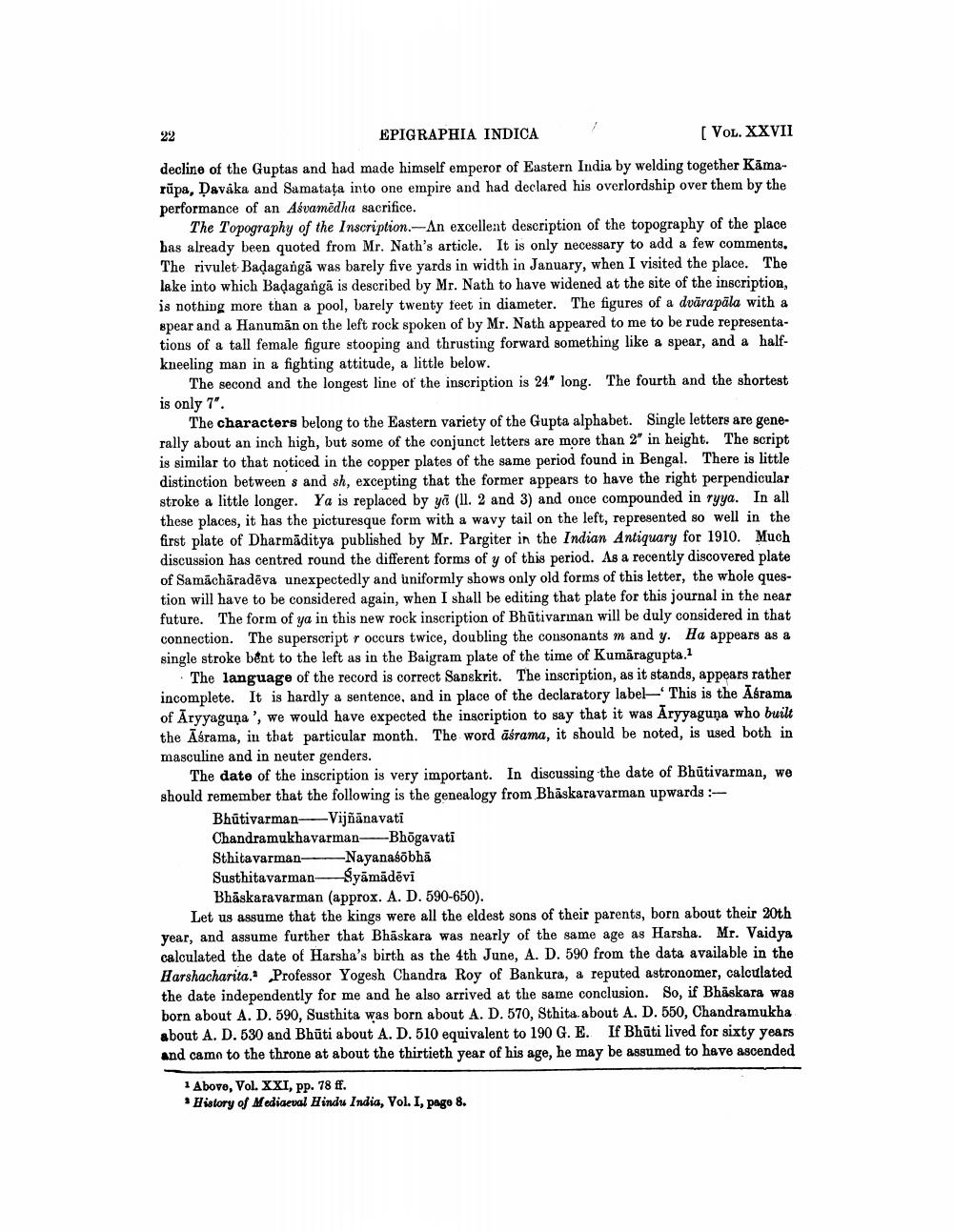________________
22
EPIGRAPHIA INDICA
(VOL. XXVII
decline of the Guptas and had made himself emperor of Eastern India by welding together Kāmarūpa, Davaka and Samatata into one empire and had declared his overlordship over them by the performance of an Aśvamëdha sacrifice.
The Topography of the Inscription. An excellent description of the topography of the place has already been quoted from Mr. Nath's article. It is only necessary to add a few comments. The rivulet Badagangā was barely five yards in width in January, when I visited the place. The lake into which Badaganga is described by Mr. Nath to have widened at the site of the inscription, is nothing more than a pool, barely twenty feet in diameter. The figures of a dvärapäla with a spear and a Hanuman on the left rock spoken of by Mr. Nath appeared to me to be rude representations of a tall female figure stooping and thrusting forward something like a spear, and a halfkneeling man in a fighting attitude, a little below.
The second and the longest line of the inscription is 24" long. The fourth and the shortest is only 7".
The characters belong to the Eastern variety of the Gupta alphabet. Single letters are generally about an inch high, but some of the conjunct letters are more than 2" in height. The script is similar to that noticed in the copper plates of the same period found in Bengal. There is little distinction between s and sh, excepting that the former appears to have the right perpendicular stroke a little longer. Ya is replaced by yä (11.2 and 3) and once compounded in ryya. In all these places, it has the picturesque form with a wavy tail on the left, represented so well in the first plate of Dharmăditya published by Mr. Pargiter in the Indian Antiquary for 1910. Much discussion has centred round the different forms of y of this period. As a recently discovered plate of Samācharadēva unexpectedly and uniformly shows only old forms of this letter, the whole question will have to be considered again, when I shall be editing that plate for this journal in the near future. The form of ya in this new rock inscription of Bhūtivarman will be duly considered in that connection. The superscript r occurs twice, doubling the consonants m and y. Ha appears as a single stroke bent to the left as in the Baigram plate of the time of Kumāragupta.
The language of the record is correct Sapskrit. The inscription, as it stands, appears rather incomplete. It is hardly a sentence, and in place of the declaratory label- This is the Asrama of Aryyaguna', we would have expected the inscription to say that it was Aryyaguna who built the Asrama, in that particular month. The word asrama, it should be noted, is used both in masculine and in neuter genders.
The date of the inscription is very important. In discussing the date of Bhūtivarman, we should remember that the following is the genealogy from Bhaskaravarman upwards
Bhūtivarman- Vijñānavati Chandramukhavarman- Bhögavati Sthitavarman- Nayanasõbhā Susthitavarman- Syāmādēvi
Bhāskaravarman (approx. A. D. 590-650). Let us assume that the kings were all the eldest sons of their parents, born about their 20th year, and assume further that Bhāskara was nearly of the same age as Harsha. Mr. Vaidya calculated the date of Harsha's birth as the 4th June, A. D. 590 from the data available in the Harshacharita. Professor Yogesh Chandra Roy of Bankura, a reputed astronomer, calculated the date independently for me and he also arrived at the same conclusion. So, if Bhāskara was born about A. D. 590, Susthita was born about A. D. 570, Sthita about A. D. 550, Chandramukha about A. D. 530 and Bhūti about A. D. 510 equivalent to 190 G. E. If Bhūti lived for sixty years and came to the throne at about the thirtieth year of his age, he may be assumed to have ascended
1 Above, Vol. XXI, pp. 78 ff. * History of Mediaeval Hindu India, Vol. I, pago 8.




